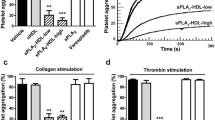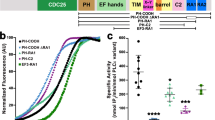Abstract
Lipoprotein-associated phospholipase A2 (Lp-PLA2) has been shown to play a crucial role in atherosclerosis, and has been proposed as a promising target for drug discovery. Here, we cloned the Lp-PLA 2 gene from differentiated THP-1 cells, and inserted a carboxy-terminal His6-tagged version of the gene into the pPIC9 Pichia expression vector. The Lp-PLA2 fusion protein was successfully expressed in Pichia pastoris expression system and could be rapidly purified to apparent homogeneity using a single-step purification method. The activity of our recombinant Lp-PLA2 was strong when [3H] PAF was used as a substrate, and the Lp-PLA2 inhibitor SB435495 exhibited an inhibitory curve against the recombinant Lp-PLA2 (IC50=15.93±1 μM). This novel recombinant Lp-PLA2 could prove useful as a screening model for Lp-PLA2 inhibitors, and may facilitate further investigation of this protein in atherosclerosis.
Similar content being viewed by others
References
Zalewski, A. and Macphee, C. (2005) Role of lipoprotein-associated phospholipase A2 in atherosclerosis: biology, epidemiology, and possible therapeutic target. Arterioscler. Thromb. Vasc. Biol. 25, 923–931.
Macphee, C. H., Moores, K. E., Boyd, H. F., et al. (1999) Lipoprotein-associated phospholipase A2, platelet-activating factor acetylhydrolase, generates two bioactive products during the oxidation of low-density lipoprotein: use of a novel inhibitor. Biochem. J. 338, 479–487.
Carpenter, K. L. H., Dennis, I. F., Challis, I. R., et al. (2001) Inhibition of lipoprotein-associated phospholipase A2 diminishes the death-inducing effects of oxidized LDL on human monocyte-macrophages. FEBS Lett. 505, 357–363.
Ballantyne, C. M., Hoogeveen, R. C., Bang, H., et al. (2004) Lipoprotein-associated phospholipase A2, high-sensitivity C-reactive protein, and risk for incident coronary heart disease in middle-aged men and women in the Atherosclerosis Risk in Communities (ARIC) study. Circulation 109, 837–842.
Oei, H. H., van der Meer, I. M., Hofman, A., et al. (2005) Lipoprotein-associated phospholipase A2 activity is associated with risk of coronary heart disease and ischemic stroke: the Rotterdam Study. Circulation 111, 570–575.
Koenig, W., Khuseyinova, N., Lowel, H., Trischler, G., and Meisinger, C. (2004) Lipoprotein-associated phospholipase A2 adds to risk prediction of incident coronary events by C-reactive protein in apparently healthy middle-aged men from the general population: results from the 14-year follow-up of a large cohort from southern Germany. Circulation 110, 1903–1908.
Brilakis, E. S., McConnell, J. P., Lennon, R. J., Elesber, A. A., Meyer, J. G., and Berger, P. B. (2005) Association of lipoprotein-associated phospholipase A2 levels with coronary artery disease risk factors, angiographic coronary artery disease, and major adverse events at follow-up. Eur. Heart J. 26, 137–144.
Iribarren, C., Gross, M. D., Darbinian, J. A., et al. (2005) Association of lipoprotein-associated phospholipase A2 mass and activity with calcified coronary plaque in young adults: the CARDIA study. Arterioscler. Thromb. Vasc. Biol. 25, 216–221.
Dada, N., Kim, N. W., and Wolfert, R. L. (2002) Lp-PLA2: an emerging biomarker of coronary heart disease. Expert Rev. Mol. Diagn. 2, 17–22.
Packard, C. J., O'Reilly, D. S. J., Wilkinson, F. E., et al. (2000) Lipoprotein-associated phospholipase A2 as an independent predictor of coronary heart disease. West of Scotland Coronary Prevention Study Group. N. Engl. J. Med. 343, 1148–1155.
Macphee, C. H. (2001) Lipoprotein-associated phospholipase A2: a potential new risk factor for coronary artery disease and a therapeutic target. Curr. Opin. Pharmacol. 1, 121–125.
Tjoelker, L. W., Wilder, C., Eberhardt, C., et al. (1995) Anti-inflammatory properties of a platelet-activating factor acetylhydrolase. Nature 374, 549–553.
Macphee, C., Benson, G. M., Shi, Y., and Zalewski, A. (2005) Lipoprotein-associated phospholipase A2: a novel marker of cardiovascular risk and potential therapeutic target. Expert Opin. Investig. Drugs 14, 671–679.
Leach, C. A., Hickey, D. M., Ife, R. J., Macphee, C. H., Smith, S. A., Tew, D. G. (2001) Lipoprotein-associated PLA2 inhibition-a novel, non-lipid lowering strategy for atherosclerosis therapy. Farmaco 56, 45–50.
Pinto, I. L., Boyd, H. F., and Hickey, D. M. B. (2000) Natural product derived inhibitors of lipoprotein associated phospholipase a2, synthesis and activity of analogues of sb-253514. Bioorg. Med. Chem. Lett. 10, 2015–2017.
Bloomer, J. C., Boyd, H. F., Hickey, D. M. B., et al. (2001) 1-(Arylpiperazinylamidoalkyl)-pyrimidones: orally active inhibitors of lipoprotein-associated phospholipase A2. Bioorg. Med. Chem. Lett. 11, 1925–1929.
Blackie, J. A., Bloomer, J. C., Brown, M. J. B., et al. (2002) The discovery of SB-435495: a potent, orally active inhibitor of lipoprotein-associated phospholipase A2 for evaluation in man. Bioorg. Med. Chem. Lett. 12, 2603–2606.
Boyd, H. F., Fell, S. C. M., Hickey, D. M. B., et al. (2002) Potent, orally active inhibitors of lipoprotein-associated phospholipase A2: 1-(biphenylmethylamidoalkyl)-pyrimidones. Bioorg. Med. Chem. Lett. 12, 51–55.
Blackie, J. A., Bloomer, J. C., Brown, M. J., et al. (2003) The identification of clinical candidate SB-480848: a potent inhibitor of lipoprotein-associated phospholipase A2. Bioorg. Med. Chem. Lett. 13, 1067–1070.
Rotella, D. P. (2004) SB-480848. GlaxoSmithKline. Curr. Opin. Investig. Drugs 5, 348–351.
Tew, D. G., Southan, C., Rice, S. Q. J., et al. (1996) Purification, properties, sequencing and cloning of a lipoprotein associated, serine dependent phospholipase which is involved in the oxidative modification of low density lipoproteins. Arterioscler. Thromb. Vasc. Biol. 16, 591–599.
Bradford, M. M. (1976) A rapid and sensitive method for the quantitation of microgram quantities of protein utilizing the principle of protein-dye binding. Anal. Biochem. 72, 248–254.
Rader, D. J. (2000) Inflammatory markers of coronary risk. N. Engl. J. Med. 343, 1179–1182.
Tselepis, A. D. and Chapman, J. M. (2002) Inflammation, bioactive lipids and atherosclerosis: potential roles of a lipoprotein-associated phospholipase A2-platelet activating factor-acetylhydrolase. Atheroscler. Suppl. 3, 57–68.
Macphee, C. H., Nelson, J. J., and Zalewski, A. (2005) Lipoprotein-associated phospholipase A2 as a target of therapy. Curr. Opin. Lipidol. 16, 442–446.
Nico-Farber, K., Harder, W., and Veenhuis, M. (1995) Review: Methylotrophic yeasts as factories for the production of foreign proteins. Yeast 11, 1331–1344.
Author information
Authors and Affiliations
Corresponding author
Rights and permissions
About this article
Cite this article
Zhang, F., Wang, Y. Cloning, expression, and purification of lipoprotein-associated phospholipase A2 in Pichia pastoris . Mol Biotechnol 33, 29–36 (2006). https://doi.org/10.1385/MB:33:1:29
Issue Date:
DOI: https://doi.org/10.1385/MB:33:1:29




